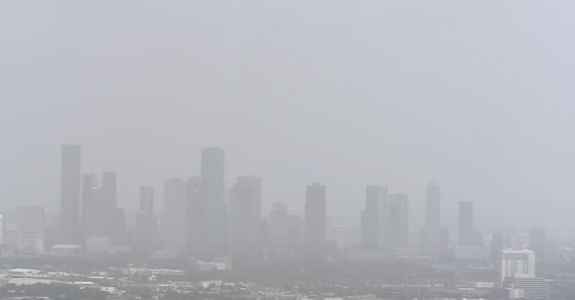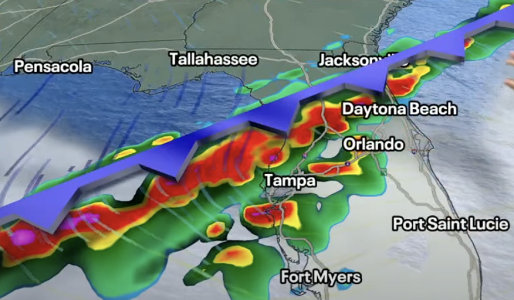Are you at risk? What you need to know about the fast-moving airborne threat heading toward the US
- Replies 1
If you’ve noticed the sky looking a little hazier than usual or your allergies acting up, you’re not alone—and you’re not imagining things.
A massive cloud of dust, born in the heart of the Sahara Desert, is barreling across the Atlantic and heading straight for Florida and the southeastern United States.
It’s a phenomenon that’s as fascinating as it is concerning, and it’s got meteorologists, health officials, and everyday folks keeping a close eye on the horizon.
What’s Blowing Your Way?
Every summer, the world’s largest desert, the Sahara, sends plumes of fine, dry dust thousands of miles across the ocean.
This year’s Saharan dust cloud is arriving earlier, denser, and more concentrated than usual, and it’s expected to linger over Florida and the Gulf Coast for several days.
If you’re in the path, you might notice hazy skies, vibrant sunsets, and—unfortunately—a dip in air quality.
Meteorologist Matt Devitt of WINK Weather in Fort Myers, Florida, recently shared a time-lapse video showing the dust cloud drifting near Key West, spreading into the Gulf of Mexico, and looping back into South Florida.

As of midweek, the cloud had already reached the Caribbean Sea, and it’s expected to make landfall in the US by the weekend.
How Does Saharan Dust Travel So Far?
It’s not magic—it’s meteorology! The Saharan Air Layer is a dry, dusty air mass that forms over the Sahara each summer.
Powerful winds, fueled by the West African Monsoon and high-pressure systems like the Bermuda-Azores High, sweep across the desert, picking up tiny particles of dust (called aeolian dust) and launching them into the atmosphere.
The African Easterly Jet then helps push this dust even higher and farther west, sometimes traveling more than 5,000 miles before settling over the Americas.
In earlier news: Why are 50,000 seniors in this state being told to stay indoors today? Here’s what you need to know.
This transatlantic journey is a regular summer event, with dust activity peaking between June and mid-August.
But the size and intensity of these plumes can vary dramatically from year to year, and scientists believe that shifting wind patterns and climate change may be making these events more frequent and more powerful.
The Double-Edged Sword: Beauty and the Beast
Let’s start with the silver lining: Saharan dust can create some of the most breathtaking sunrises and sunsets you’ll ever see.
The fine particles scatter sunlight, painting the sky in warm, glowing hues of orange, pink, and red. If you’re a photographer or just someone who loves a good sunset, keep your camera handy!

But there’s a flip side. The same dust that makes the sky beautiful can also make the air tough to breathe.
The fine particles are small enough to get deep into your lungs, which can be especially problematic for people with asthma, allergies, COPD, or other respiratory issues. Even healthy individuals might notice itchy eyes, scratchy throats, or a persistent cough.
Who’s Most at Risk?
According to the Centers for Disease Control and Prevention (CDC) and the National Weather Service (NWS), the following groups should be especially cautious during a Saharan dust event:
- Older adults
- Children
- People with asthma, COPD, or other lung conditions
- Anyone with heart disease or compromised immune systems
Also read: Does your car smell musty? This overlooked part could be the surprising cause!
If you fall into one of these categories, it’s a good idea to limit your time outdoors when the dust is thick, keep windows closed, and use air purifiers if you have them.
If you start to feel short of breath, wheezy, or develop chest pain, don’t hesitate to contact your healthcare provider.
Source: FOX 35 Orlando / Youtube.
A Look Back: When Dust Clouds Made Headlines
This isn’t the first time Saharan dust has made its presence known in the US. In June 2020, the so-called “Godzilla plume” swept from West Africa across the Atlantic, bringing hazy skies and air quality alerts from Texas to the Carolinas. The National Oceanic and Atmospheric Administration (NOAA) called it the largest event in nearly 50 years.
Just last July, another thick wave of Saharan dust blanketed Florida, Texas, Louisiana, Alabama, and Mississippi, turning skies orange and pushing air quality into the “unhealthy for sensitive groups” category in cities like Miami and Houston.
This year’s plume is arriving earlier and is denser than previous years, raising concerns among health officials and meteorologists alike.
Read next: Brace yourself! Extreme storms are sweeping the nation—are YOU in the danger zone?

Have you experienced a Saharan dust event before? Did you notice any changes in your health or the way the sky looked? Do you have tips for managing allergies or asthma during these dusty days? We’d love to hear your stories, advice, and questions in the comments below!
A massive cloud of dust, born in the heart of the Sahara Desert, is barreling across the Atlantic and heading straight for Florida and the southeastern United States.
It’s a phenomenon that’s as fascinating as it is concerning, and it’s got meteorologists, health officials, and everyday folks keeping a close eye on the horizon.
What’s Blowing Your Way?
Every summer, the world’s largest desert, the Sahara, sends plumes of fine, dry dust thousands of miles across the ocean.
This year’s Saharan dust cloud is arriving earlier, denser, and more concentrated than usual, and it’s expected to linger over Florida and the Gulf Coast for several days.
If you’re in the path, you might notice hazy skies, vibrant sunsets, and—unfortunately—a dip in air quality.
Meteorologist Matt Devitt of WINK Weather in Fort Myers, Florida, recently shared a time-lapse video showing the dust cloud drifting near Key West, spreading into the Gulf of Mexico, and looping back into South Florida.

A massive cloud of Saharan dust is on track to reach Florida and parts of the southeastern US in the coming days, causing potential air quality issues and health risks, especially for people with respiratory conditions. Image source: KPRC 2 Click2Houston / Youtube.
As of midweek, the cloud had already reached the Caribbean Sea, and it’s expected to make landfall in the US by the weekend.
How Does Saharan Dust Travel So Far?
It’s not magic—it’s meteorology! The Saharan Air Layer is a dry, dusty air mass that forms over the Sahara each summer.
Powerful winds, fueled by the West African Monsoon and high-pressure systems like the Bermuda-Azores High, sweep across the desert, picking up tiny particles of dust (called aeolian dust) and launching them into the atmosphere.
The African Easterly Jet then helps push this dust even higher and farther west, sometimes traveling more than 5,000 miles before settling over the Americas.
In earlier news: Why are 50,000 seniors in this state being told to stay indoors today? Here’s what you need to know.
This transatlantic journey is a regular summer event, with dust activity peaking between June and mid-August.
But the size and intensity of these plumes can vary dramatically from year to year, and scientists believe that shifting wind patterns and climate change may be making these events more frequent and more powerful.
The Double-Edged Sword: Beauty and the Beast
Let’s start with the silver lining: Saharan dust can create some of the most breathtaking sunrises and sunsets you’ll ever see.
The fine particles scatter sunlight, painting the sky in warm, glowing hues of orange, pink, and red. If you’re a photographer or just someone who loves a good sunset, keep your camera handy!

Experts warn that the fine particles in the dust cloud can irritate the lungs, eyes, nose, and throat, with children, the elderly, and those with asthma or heart/lung problems most at risk. Image source: FOX 35 Orlando / Youtube.
But there’s a flip side. The same dust that makes the sky beautiful can also make the air tough to breathe.
The fine particles are small enough to get deep into your lungs, which can be especially problematic for people with asthma, allergies, COPD, or other respiratory issues. Even healthy individuals might notice itchy eyes, scratchy throats, or a persistent cough.
Who’s Most at Risk?
According to the Centers for Disease Control and Prevention (CDC) and the National Weather Service (NWS), the following groups should be especially cautious during a Saharan dust event:
- Older adults
- Children
- People with asthma, COPD, or other lung conditions
- Anyone with heart disease or compromised immune systems
Also read: Does your car smell musty? This overlooked part could be the surprising cause!
If you fall into one of these categories, it’s a good idea to limit your time outdoors when the dust is thick, keep windows closed, and use air purifiers if you have them.
If you start to feel short of breath, wheezy, or develop chest pain, don’t hesitate to contact your healthcare provider.
Source: FOX 35 Orlando / Youtube.
A Look Back: When Dust Clouds Made Headlines
This isn’t the first time Saharan dust has made its presence known in the US. In June 2020, the so-called “Godzilla plume” swept from West Africa across the Atlantic, bringing hazy skies and air quality alerts from Texas to the Carolinas. The National Oceanic and Atmospheric Administration (NOAA) called it the largest event in nearly 50 years.
Just last July, another thick wave of Saharan dust blanketed Florida, Texas, Louisiana, Alabama, and Mississippi, turning skies orange and pushing air quality into the “unhealthy for sensitive groups” category in cities like Miami and Houston.
This year’s plume is arriving earlier and is denser than previous years, raising concerns among health officials and meteorologists alike.
Read next: Brace yourself! Extreme storms are sweeping the nation—are YOU in the danger zone?
Key Takeaways
- A massive cloud of Saharan dust is on track to reach Florida and parts of the southeastern US in the coming days, causing potential air quality issues and health risks, especially for people with respiratory conditions.
- Experts warn that the fine particles in the dust cloud can irritate the lungs, eyes, nose, and throat, with children, the elderly, and those with asthma or heart/lung problems most at risk.
- While the dust can make breathing difficult and turn skies hazy, it also tends to create beautiful, colourful sunrises and sunsets, plus can help suppress hurricanes by drying out the air.
- This year’s Saharan dust plume is arriving earlier, is denser, and has higher levels of fine particles than usual, prompting extra public health warnings and attention from meteorologists and health officials.
Have you experienced a Saharan dust event before? Did you notice any changes in your health or the way the sky looked? Do you have tips for managing allergies or asthma during these dusty days? We’d love to hear your stories, advice, and questions in the comments below!






